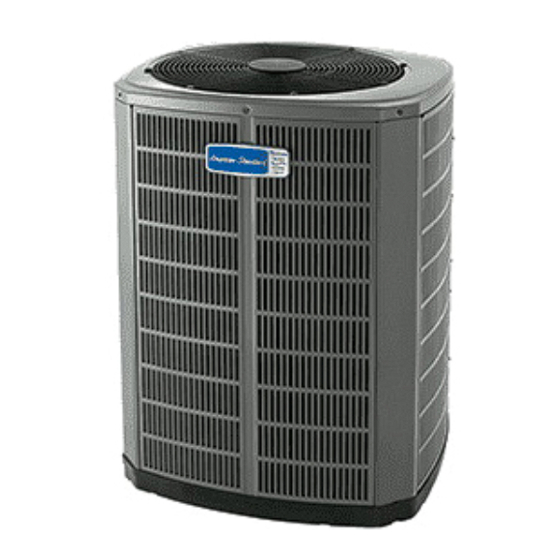
Table of Contents
Advertisement
ALL phases of this installation must comply with NATIONAL, STATE AND LOCAL CODES
IMPORTANT - This Document is customer property and is to remain with this unit. Please return to service informa-
tion pack upon completion of work.
These instructions do not cover all variations in systems or provide for every possible contingency to be met in connection with
the installation. Should further information be desired or should particular problems arise which are not covered sufficiently for the
purchaser's purposes, the matter should be referred to your installing dealer or local distributor.
Note: The manufacturer recommends installing only approved matched indoor and outdoor systems. All of the manufacture's split
systems are AHRI rated only with TXV/EEV indoor systems. Some of the benefits of installing approved matched indoor and out-
door split systems are maximum efficiency, optimum performance and the best overall system reliability.
Table of Contents
Section 1. Safety ..................................................................................... 2
Section 2. Unit Location Considerations ............................................. 3
Section 3. Unit Preparation .................................................................... 5
Section 4. Setting the Unit ..................................................................... 5
Section 5. Refrigerant Line Considerations ......................................... 6
Section 6. Refrigerant Line Routing ..................................................... 7
Section 7. Refrigerant Line Brazing ...................................................... 8
Section 8. Refrigerant Line Leak Check ............................................. 10
Section 9. Evacuation .......................................................................... 11
Section 10. Service Valves .................................................................. 11
Section 11. Electrical - Low Voltage ................................................... 12
Section 12. Electrical - High Voltage .................................................. 15
Section 13. Start Up .............................................................................. 16
Section 14. System Charge Adjustment ............................................. 17
Section 15. Checkout Procedures and Troubleshooting .................. 24
Installer's Guide
Heat Pumps
4A6H4
11-BC38D1-5C-EN
Advertisement
Table of Contents

Summarization of Contents
Section 2. Unit Location Considerations
Unit Dimensions and Weight
Details the physical dimensions and weight of various unit models.
Refrigerant Piping Limits
Specifies the maximum total length and vertical change for refrigerant lines.
Suggested Locations for Best Reliability
Provides guidance on optimal placement to ensure proper airflow and prevent noise issues.
Cold Climate Considerations
Offers advice for installations in areas prone to snow and freezing temperatures.
Coastal Considerations
Addresses installation requirements for coastal environments near salt water.
Section 3. Unit Preparation
Prepare The Unit For Installation
Outlines steps for checking and removing the unit from its packaging.
Section 4. Setting the Unit
Pad Installation
Lists considerations for properly installing the unit's support pad.
Section 5. Refrigerant Line Considerations
Refrigerant Line and Service Valve Connection Sizes
Provides a table detailing line and valve connection sizes for different models.
Factory Charge
Explains the factory charge and the importance of verifying system charge.
Required Refrigerant Line Length
Instructs on determining and recording line length and vertical lift.
Refrigerant Line Insulation
Emphasizes the need for proper insulation of the vapor line.
Reuse Existing Refrigerant Lines
Offers precautions for using existing refrigerant lines in retrofit applications.
Section 6. Refrigerant Line Routing
Precautions
Details steps to prevent noise from vibration transmission through refrigerant lines.
Section 7. Refrigerant Line Brazing
Braze The Refrigerant Lines
Provides step-by-step instructions for brazing refrigerant lines.
Section 8. Refrigerant Line Leak Check
Check For Leaks
Describes the procedure for pressurizing lines and checking for leaks.
Section 9. Evacuation
Evacuate the Refrigerant Lines and Indoor Coil
Explains how to evacuate the system to the required micron level.
Section 10. Service Valves
Open the Gas Service Valve
Details the procedure for opening the gas service valve.
Open the Liquid Service Valve
Provides instructions and warnings for opening the liquid service valve.
Section 11. Electrical - Low Voltage
Low Voltage Maximum Wire Length
Defines maximum wire lengths for low voltage connections based on gauge.
Low Voltage Hook-up Diagrams
Illustrates low voltage wiring connections for different thermostat systems.
Defrost Control - All Models except 036
Explains defrost control operation and configuration for specific models.
Defrost Control - 036 Model ONLY
Details defrost control settings and operation specifically for the 036 model.
Section 12. Electrical - High Voltage
High Voltage Power Supply
Covers safety and compliance requirements for high voltage power supply.
High Voltage Disconnect Switch
Recommends installing a separate disconnect switch for high voltage connections.
High Voltage Ground
Stresses the importance of proper grounding for the outdoor unit.
Section 13. Start Up
System Start Up
Provides a step-by-step guide for starting up the installed system.
Section 14. System Charge Adjustment
Temperature Measurements
Explains the necessary temperature measurements for system charging.
Subcooling Charging in Cooling (Above 55° F Outdoor Temp.)
Details the subcooling method for charging systems in cooling mode above 55°F.
Subcooling Charging Below 55° F Outdoor Temp. (In Heating Only)
Describes the weigh-in method for charging below 55°F outdoor temperature.
Section 15. Checkout Procedures and Troubleshooting
Operational And Checkout Procedures
Lists essential checks to ensure proper performance and safe operation.
Troubleshooting
Provides a fault diagnostic chart for common system issues.















Need help?
Do you have a question about the 4A6H4024N and is the answer not in the manual?
Questions and answers